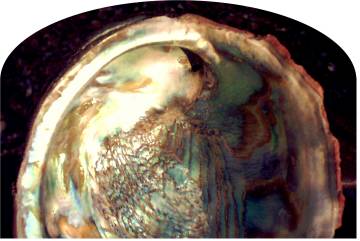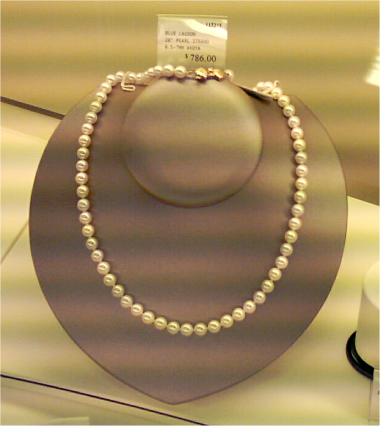|
Types of PearlsTypes of pearls fall into two main categories: Freshwater & Saltwater.
Saltwater pearls--found or cultivated in salt water oysters in a bay, ocean, gulf, or sea. These also can be irregular in shape, especially when natural, although the best cultured ones are known for their fine round shape. Each type may be either natural (nature made) or cultured (man induced) and inside each category are different varieties of pearls. A separate category may also include pearls from snails, as most pearls come from bivalve mussels or oysters (having 2 shells which close together). I enjoyed learning at the traveling pearl exhibition that any mollusk can grow pearls...pretty exciting.
Abalone Pearls See Blue Pearls below for information about cultured abalone pearls. 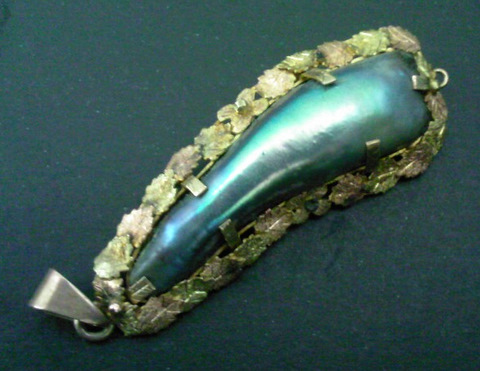 Natural Abalone Pearl Pendant Akoya Pearls Pearls from the Akoya oyster are probably the most popular types of pearls, Pinctada fucata martensii, and are sought after for their round shape. Most are cultured with natural colors ranging from light pink, white or yellowish. Japan cultures most akoya pearls over 7mm, while smaller sizes are cultured in China, Korea, Hong Kong and Sri Lanka.
Bar pearls Pearls produced by inserting flat or elongated discs, usually made of a plastic material instead of mother-of-pearl beads. Basra Pearls Pearls found in the Persian Gulf (also called Arabian Gulf) from Pinctada radiata oyster. 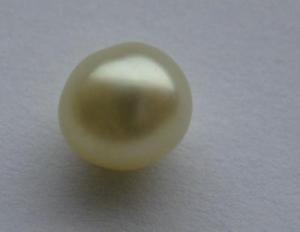 Basra Pearl Biwa Pearls Lake Biwa is Japan's largest lake, therefore the types of pearls cultivated there are freshwater pearls. Here is one of the first places where pearls were cultivated but unfortunately the lake is now very polluted. Because of the reputation of Biwa pearls, which were high quality, dealers will sometimes use the term, "Biwa," falsely to impress buyers.

Another name for these solid cultured blister pearls is under the registered trade mark of "Dome'." Tennessee in the USA cultivates these in high quality and a variety of shapes. After hollow blister pearls are prepared for mounting, they are called Mabe...see below.
Blue Pearls 1. One of the types of blue pearls comes from the silver-lip oyster when there is a contaminant either in the nacre or between the nacre and the shell bead.
2. Other types of pearls called blue comes from the Abalone (which is technically a large snail of the genus, Haliotis. Up until 1989, pearls were only found naturally and occasionally in the abalone. The chances of finding an abalone pearl of any size is one in 50,000. They are found off the shores in California, Oregon, Alaska, Mexico, Japan, Korea, South Africa, Australia and New Zealand (see natural abalone pearls) and colors are varied and lustrous...from green, blue, pink, (blue and pink are most desired) purple, silver and sometimes cream white. Natural abalone pearls are usually baroque shapes which makes for creative jewelry pieces. You can expect to pay from $200 to $2000 per carat.
Since 1989, New Zealander, Roger Beattie, has been successfully cultivating blue mabe pearls at Whangamoe Inlet on New Zealand's Chatham Islands, the Marlborough Sounds, Banks Peninsula and Wellington Harbour, from the Abalone species, Paua or Haliotis iris. Blue Mussel Pearls Pearls from the blue mussel saltwater mollusk. 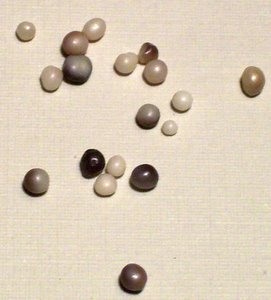 Blue Mussel Pearls Button Pearls Types of pearls which are round in circumference, but flattened somewhat, like a button. 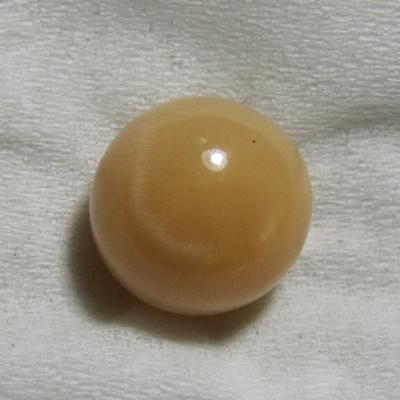 Cassis Pearl 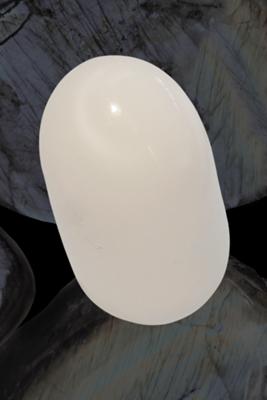 144 ct clam pearl Coin Pearls Types of pearls that have been cultured to the shape of coins. I've found these to be popular with younger women. Other shapes that freshwater cultured pearls come in are diamond, square, rectangle, and stick.
Carved Pearls Carving on pearls is an added enhancement and can be done in a variety of ways. For example, if a gemstone is used as a nucleus the carving can reveal this colorful center. 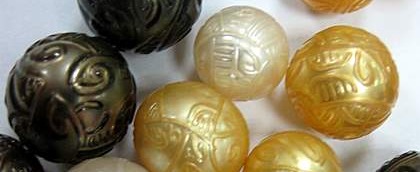 Carved Pearls Chinese Kasumigauras Pearls produced by inserting round, drilled mother-of-pearl beads together with a tiny piece of donor mantle-tissue into the mussel’s body, preferably the gonad. Up to 2 pearls can be produced. Coin pearls Pearls produced by inserting flat or elongated discs, usually made of a plastic material instead of mother-of-pearl beads. Comets Pearls produced by inserting round mother-of-pearl beads into pearl-sacks inside of the mussel’s mantle that exist already from a previous harvest of non-beaded pearls. Up to more than 20 pearls can be produced on each side of the mantle. 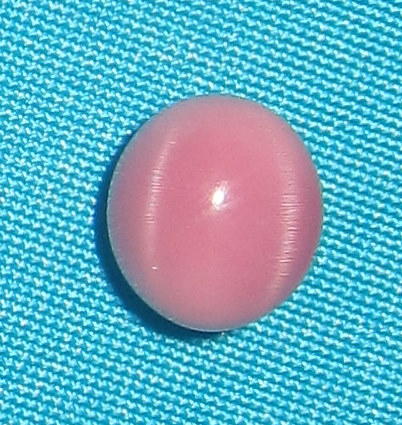 Conch Pearl with Flame
Edison pearls Pearls produced by inserting round, drilled mother-of-pearl beads together with a tiny piece of donor mantle-tissue into the mussel’s body, preferably the gonad. Up to 2 pearls can be produced.
Faceted Pearls Types of pearls that appear to have many sections on the surface, sort of like a cut diamond. This faceting makes for a sparkling effect and allows flaws to be polished away. 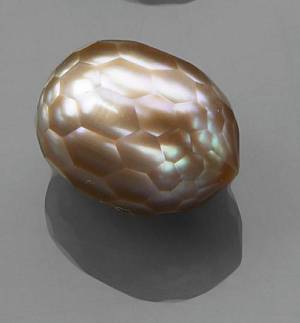 Faceted Pearl (Bonham's photo used with permission) Fireballs Pearls produced by inserting round mother-of-pearl beads into pearl-sacks inside of the mussel’s mantle that exist already from a previous harvest of non-beaded pearls. Up to more than 20 pearls can be produced on each side of the mantle. Flames Pearls produced by inserting round mother-of-pearl beads into pearl-sacks inside of the mussel’s mantle that exist already from a previous harvest of non-beaded pearls. Up to more than 20 pearls can be produced on each side of the mantle.
Freshwater Pearls - Natural Those that grow naturally in fresh or sweet water. 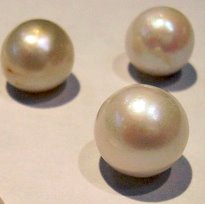 Natural USA river pearls Freshwater - Cultured, Lavender Raised on pearl farms with human intervention. Lavender can be a natural color. 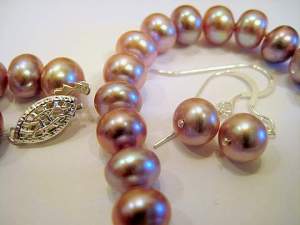 Lavender Cultured Pearls Freshwater - Cultured, Pink Raised on pearl farms with human intervention. Freshwater - Cultured, Multicolored Raised on pearl farms with human intervention. Freshwater - Cultured, White Raised on pearl farms with human intervention. Giant Clam Pearls Pearls from the giant clam, tridacna gigas. 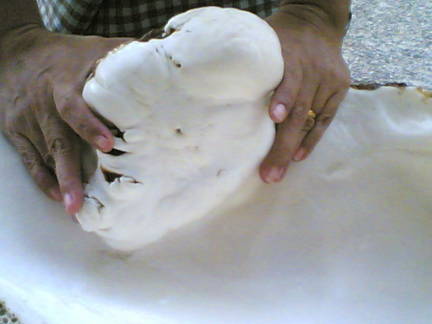 Giant Clam Blister Pearl Gem-studded Pearls Drilling holes in pearls and inserting gems not only adds to the natural beauty of a pearl but can also effectively eliminate flaws or pits. Half Pearls Types of pearls that has been sawed or ground on one side usually to remove blemishes. Once mounted it can often look like a whole pearl. If it's only sawed slightly it can be called a three-quarter pearl. Button pearls can look like half pearls when mounted. Ikecho pearls Pearls produced by inserting round, drilled mother-of-pearl beads together with a tiny piece of donor mantle-tissue into the mussel’s body, preferably the gonad. Up to 2 pearls can be produced.
In Body pearls or In-Bodies Pearls produced by inserting round, drilled mother-of-pearl beads together with a tiny piece of donor mantle-tissue into the mussel’s body, preferably the gonad. Up to 2 pearls can be produced. Kasumiga Pearls Types of pearls cultured in Lake Kasumiga, which is north of Toyko. Kasumiga is a trade mark protected name, but these pearls also called Kasumi Pearls. They come from the hybrid mussels Hyriopsis schlegelii X Hyriopsis cumingii and introduced to the market in 1990's in limited qualities. They range in color from gold to white to purple to pink.These large nucleated freshwater pearls measure from 11-16 mm. Keshi Pearls Types of pearls that grow naturally in the soft tissue or abductor muscle of cultured pearl bearing mollusks. Here are five meanings for the word Keshi. 1. Chinese reborn pearls are really Keshi-like pearls found in the second harvest, but not true Keshi because they are cultivated, although sometimes sold as Keshi pearls. 2. Natural seed pearls Even before pearls were cultivated, the term Keshi was used for these tiny natural pearls. 3. Accidents of cultured freshwater pearl process. These are found in the second and third harvest and caused by natural irritants. 4. Accidents of South Sea and black pearl oyster culturing process. Natural pearls occurring in any of the three harvests of a single oyster. 5. Accidents of Japanese Akoya pearl oyster culturing process. The Akoya oyster has only one harvest, and Keshi pearl sometimes form during that one implantation. Lentil pearls Pearls produced by inserting flat or elongated discs, usually made of a plastic material instead of mother-of-pearl beads. Mabe Pearls After blister pearls are prepared for mounting in jewelry they are called mabe (MAH-bay) pearls. After removing the implant from the shell, the plastic or soapstone is removed and the back filled with a paste or wax, then covered with a mother of pearl backing. When mounted mabe pearls look like solid blister pearls or even half pearls, therefore, the terms are sometimes used interchangeably.  Mabe pearls "Mabe" oysters, or Pteria penguin known for their luster, color and iridescence produce mabe pearls which are more valuable than those grown in the silver-lip or black-lip oysters. Ming pearls Pearls produced by inserting round, drilled mother-of-pearl beads together with a tiny piece of donor mantle-tissue into the mussel’s body, preferably the gonad. Up to 2 pearls can be produced. Melo Pearls Pearls occurring naturally and rarely in sea snails called bailer shells, melon shells or boat shells (melo melo) off Singapore and Malaysia and in the south China Sea. These large pearls, usually weighing 200 carats, com in orange, yellow or brownish colors with a wavy pattern. 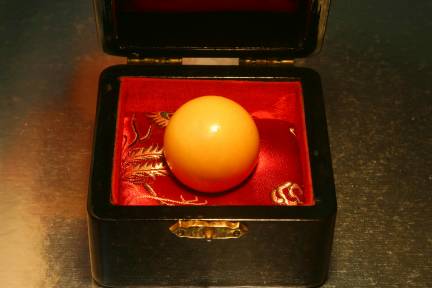 Largest Melo Pearl
Mikimoto Pearls Top quality Akoya pearls sold by the Mikimoto Co. Only the top 3-5% of pearls are chosen and used by Mikimoto Co. which was started by Kokichi Mikimoto, the Japanese gentleman given credit for establishing the present world-wide cultured pearl business. A signature clasp will always be on a genuine Mikimoto piece, although the company also has lower quality lines, such as the Blue Lagoon line which are more affordable. Read more about Mikimoto here. Oriental Pearls By the standards of the US Federal Trade Commission, oriental pearls are natural pearls found in oysters of the Persian Gulf (Arabian Gulf) or those that look like pearls found there. 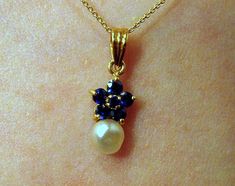 Oriental Pearl Pendant A term also used for any natural saltwater pearl found in the Red sea, the Persian Gulf or the Gulf of Manmar off the west coast of Sri Lanka. Koyi Wada, a pearl researcher, says in Pearls of the World that oriental pearls are "natural pearls from one kind of sea-water pearl oyster called the wing shell." PearlOpal PearlOpal is created by implanting an opal into a live pearl shell.
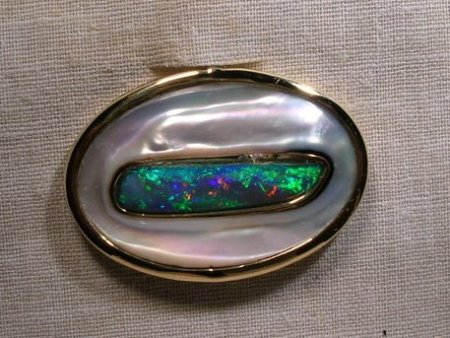 PearlOpal Jewelry
Quahog pearls A hard clam (Mercenaria mercenaria), also known a quahaug, round clam, hard-shell, little neck, or cherry stone clam, is an edible marine bivalve mollusk which is native to the eastern shores of North America, from Prince Edward Island to the Yucatán Peninsula. 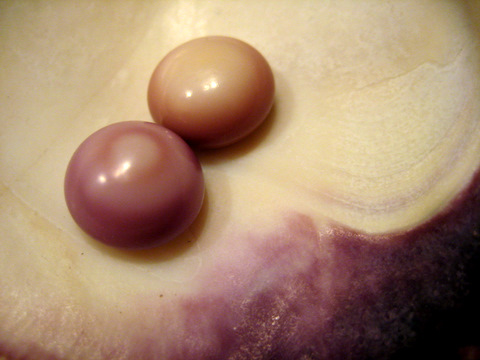 Quahog Pearls on Shell Rainbow Pearls Pearls having 3 or 4 color variations in them from the Western winged (rainbow-lipped) pearl oyster (Pteria sterna). The Pacific Coast from California to Peru, as well as Guaymas, Mexico, is home to this oyster. When developed naturally, they can be from seed to 30-carat size and range from $100 to $2000 per carat wholesale. As cultured pearls they are usually 7-12mm in diameter and less expensive than natural rainbow pearls. Rosebud Pearls Pearls with several bumps on them making them resemble a rose bud. Also called "strawberry pearls" because the look like small strawberries with seeds on the outside.
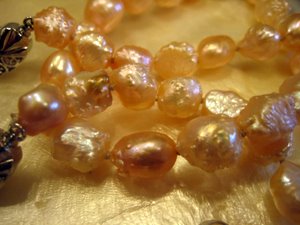 Rosebud Pearls Scallop Pearls Pearls found in various scallop mollusks. 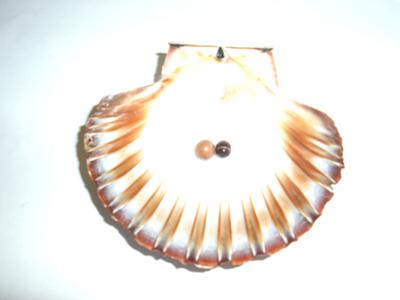 Scallop Pearls from Tasmania
Seed Pearls Small pearls the size and appearance of seeds. 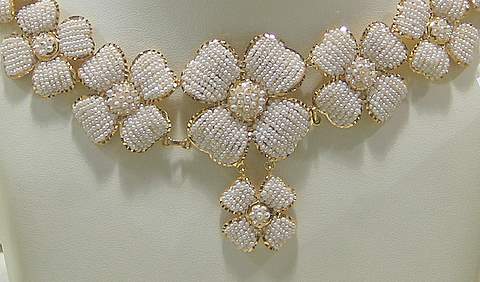 Seed Pearl Necklace Soufflé pearls or Soufflés Pearls produced by inserting lumps of mud instead of mother-of-pearl beads. South Sea Pearls Usually refers to large white or yellow types of pearls grown by the Pinctada maxima oyster which lives in the South Seas, also called silver-lip or yellow-lip oyster. South Sea Pearls can also mean any saltwater pearl found from the Philippines and Indonesia down to Australia and across to French Polynesia. These pearls often are 9-19mm in size. 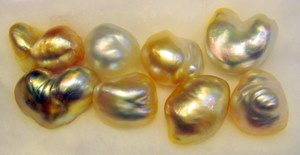 South Sea Baroque Pearls Tahitian Pearls Tahiti holds to strict exporting laws which only allow a certain quality of cultured pearls to leave their country, assuring you that you have an excellent piece of fine jewelry. 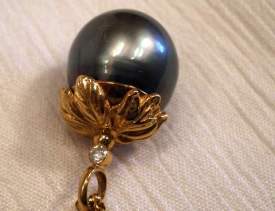 Tahitian and Diamond Pendant Yellow Pearls Occur both naturally and can be cultured. South Sea are the most common, but can occur in other shells as well.
Special thanks to Renee Newman GG for some of this information on types of pearls in her book, Pearl Buying Guide.
|






